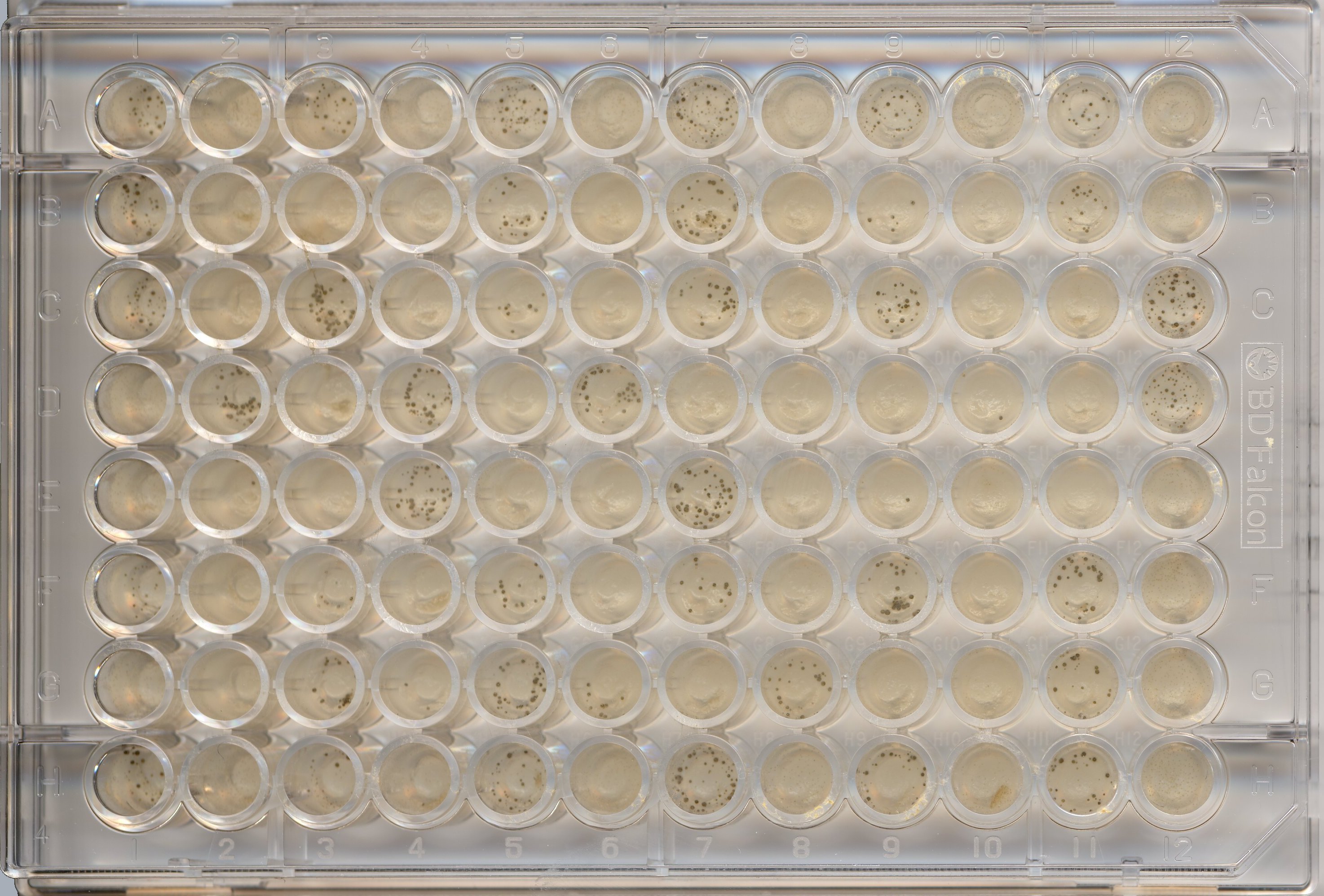High throughput mating tests in Neurospora crassa
Kevin McCluskey, Rachel L. Yedlin and Sheera A. Walker
Fungal Genetics Stock Center, School of Biological Sciences, University of Missouri- Kansas City.
Fungal Genetics Newsletter 53:20-22
Mating type tests in Neurospora crassa can be laborious and tedious. Since we were arraying mutants for distribution, we have developed a method to carry out mating type tests in 96-well plates. This technique is highly efficient and reproducible and gives results in three to four days.
Mating type tests in Neurospora crassa are an important way to characterize strains. Since most of the knock-out mutants developed as part of the functional genomics program (Colot et al., 2006) have little obvious phenotype we have undertaken to test the mating type of all of the knock-strains that are sent to the FGSC. Our original mating type test protocol is similar to that described by Smith (1962) and involves growing a lawn of the fluffy tester strains (4317 or 4347) on cornmeal agar (Difco) in 15 cm petri plates. This is also described in the online Neurospora protocol, "How to use fluffy testers for determining mating type and for other applications" (http://www.fgsc.net/Neurospora/NeurosporaProtocolGuide.htm). . The strains to be tested are grown on Vogels minimal (Vogel, 1956) or appropriately supplemented medium (McCluskey, 2003) and small amounts of conidia are transferred to a spot on a grid. Using this technique, thirty to forty strains can be tested on two plates. While robust, this technique is labor intensive and because the plate is opened for each inoculation there is the possibility that occasional stray conidia could confound the results.
To avoid introducing a rate limiting step into the processing of strains at the FGSC, we have implemented a mass-inoculation protocol to carry out mating tests in 96-well plates. Mating plates were prepared by aliquoting approximately 75ul of sterilized cornmeal agar (Difco) into each well of a 96-well plate. This medium was chosen because it supports rapid but thin growth of fluffy mycelia and is readily available. To carry out the mating test, we prepared a suspension of mycelial fragments and micro-conidia from seven to ten day old slant cultures of strains FGSC 4317 (fl; mat a) and 4247 (fl; mat A) by flooding a 5-10 day old slant with water and then macerating the mycelia using a sterile weighing spatula. Ten micro-liters of this suspension (containing 5 - 20 mycelial fragments as observed with a compound microscope) was transferred into each well of a prepared cornmeal agar plate using a 12-channel pipettor. The plates were incubated for 16 to 36 hrs at room temperature. Conidial suspensions of knock-out mutants in 3.5% sterile non-fat dry milk, 25% glycerol were prepared in a 96-well plate. These were either frozen at -80 or tested directly before freezing.

The mating reaction was clearly developed after two days and perethecia had started to darken. The appearance of mating was not confused by the presence of protoperithecia as shown in figure 2. Well H7 shows abundant perithecia while well H8 shows protoperithecia.

Table 1. False mating reactions out of 782 strains tested.
| FGSC # 4317 | FGSC # 4347 | ||
| Preliminary False Negative | Preliminary False Positive | Preliminary False Negative | Preliminary False Positive |
| 31 | 6 | 78 | 10 |
| Mating type re-confirmed on plate test | Mating type re-confirmed on plate test | ||
| 25 | 4 | 71 | 7 |
| Final False Negative | Final False Positive | Final False Negative | Final False Positive |
| 6 | 2 | 7 | 3 |
References
Colot, H. V., Park, G., Turner, G.E., Ringelberg, C., Crew, C.M. Litvinkova, L., Weiss, R.L., Borkovich, K. A., and Dunlap, J.C. A high-throughput gene knockout procedure for Neurospora reveals functions for multiple transcription factors. PNAS 2006 103: 10352-10357
Galagan, James E. et al. 2003. The genome sequence of the filamentous fungus Neurospora crassa. Nature 422, 859 - 868.
McCluskey, K. 2003. The Fungal Genetics Stock Center: from Molds to Molecules. In "Advances in Applied Microbiology Volume 52" (Laskin and Bennett, Eds.) Elsevier USA. pp 246-262.
Smith, B. R. 1962. Mating type tests using plating technique. Neurospora Newsl. 1: 14.
Vogel, H. J. 1956. A convenient growth medium for Neurospora (Medium N). Microbial. Genet. Bull. 13: 42-43.
Return to the FGN 53 Table of Contents